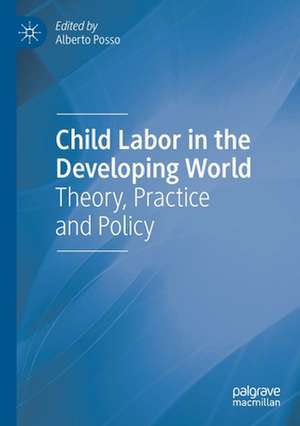Child Labor in the Developing World: Theory, Practice and Policy
Editat de Alberto Possoen Limba Engleză Paperback – 22 iul 2021
The volume is made up of three sections. The first section builds on the existing literature and provides new theoretical insights into child labor. Section 2 provides empirical evidence from both quantitative and qualitative case studies on child labor from across Asia, Africa and Latin America. This section provides information from studies conducted in Brazil, Cameroon, the Dominican Republic, India and Vietnam. Section 3provides policy recommendations.
| Toate formatele și edițiile | Preț | Express |
|---|---|---|
| Paperback (1) | 637.93 lei 6-8 săpt. | |
| Springer Nature Singapore – 22 iul 2021 | 637.93 lei 6-8 săpt. | |
| Hardback (1) | 644.63 lei 6-8 săpt. | |
| Springer Nature Singapore – 21 iul 2020 | 644.63 lei 6-8 săpt. |
Preț: 637.93 lei
Preț vechi: 750.50 lei
-15% Nou
Puncte Express: 957
Preț estimativ în valută:
122.12€ • 125.66$ • 102.94£
122.12€ • 125.66$ • 102.94£
Carte tipărită la comandă
Livrare economică 01-15 martie
Preluare comenzi: 021 569.72.76
Specificații
ISBN-13: 9789811531088
ISBN-10: 9811531080
Pagini: 273
Ilustrații: XVIII, 273 p. 26 illus.
Dimensiuni: 148 x 210 mm
Greutate: 0.35 kg
Ediția:1st ed. 2020
Editura: Springer Nature Singapore
Colecția Palgrave Macmillan
Locul publicării:Singapore, Singapore
ISBN-10: 9811531080
Pagini: 273
Ilustrații: XVIII, 273 p. 26 illus.
Dimensiuni: 148 x 210 mm
Greutate: 0.35 kg
Ediția:1st ed. 2020
Editura: Springer Nature Singapore
Colecția Palgrave Macmillan
Locul publicării:Singapore, Singapore
Cuprins
Chapter 1. Introduction and overview of the model.- Chapter 2. Child labor and the macroeconomy.- Chapter 3. Microeconomics of child labor: Child labor, optimum savings and human capital accumulation.- Chapter 4. Is there a Culture of Child Labor? The Decision-making process of working, with special reference to the Girl Beedi rollers in Jhalda region of Purulia, West Bengal.- Chapter 5. Income shocks and child labor: evidence from the Dominican Republic.- Chapter 6. The effects of migration on child education and on engagement in different types of child labor in Vietnam: A simultaneous equation approach.- Chapter 7. The effect of child labor on primary education in Brazil.- Chapter 8. The role of parental characteristics on child labor participation and hours worked in Cameroon.- Chapter 9. Child Labor in a Pastoral Tribe of Jammu and Kashmir: Impact of Spatiality within a State of Conflict.- Chapter 10. Overall policy findings.
Notă biografică
Alberto Posso is a Professor of Economics and Director at the Centre for International Development in the Royal Melbourne Institute of Technology (RMIT), Australia. Professor Posso holds a PhD in Economics from the Australian National University (ANU) with specialisations in labor economics, economic development, international trade and applied econometrics. Geographically, his research focuses on East Asia, Latin America and the Pacific. Professor Posso has over 40 peer-reviewed publications, which include papers in leading outlets for Development Studies such as World Development, The Journal of Development Studies and The Review of Development Economics. Professor Posso’s most recent research work focuses on child labor, its causes and consequences. He has worked on the adult-wage effects of child labor in Ecuador, the health consequences of child labor in Peru, the psychological costs of child labor in India, as well as the relationship between environmental shocks and child labor in Vietnam. His work on child wellbeing, more generally, has been funded by major international organizations including Oxfam, Plan International, and UNESCAP.
Textul de pe ultima copertă
This book provides new evidence of the theoretical and empirical causes and consequences of child labor. In so doing, the chapters provide a unique set of policy prescriptions that are applicable to both the developing countries that make up the case studies of the volume, as well as other countries more broadly. The volume is constructed to inform policy with rigorous analysis. However, unlike most academic studies, the language and flavour of the volume is largely non-technical, while the policy recommendations are practical.
The volume is made up of three sections. The first section builds on the existing literature and provides new theoretical insights into child labor. Section 2 provides empirical evidence from both quantitative and qualitative case studies on child labor from across Asia, Africa and Latin America. This section provides information from studies conducted in Brazil, Cameroon, the Dominican Republic, India and Vietnam. Section3 provides policy recommendations.
The volume is made up of three sections. The first section builds on the existing literature and provides new theoretical insights into child labor. Section 2 provides empirical evidence from both quantitative and qualitative case studies on child labor from across Asia, Africa and Latin America. This section provides information from studies conducted in Brazil, Cameroon, the Dominican Republic, India and Vietnam. Section3 provides policy recommendations.
Caracteristici
Provides new evidence of the theoretical and empirical causes and consequences of child labor Collects case studies from Africa, Asia and Latin America to provide a unique set of policy prescriptions Constructed to inform policy and learning, aiming to reach a broad audience of scholars and policymakers
